Orbital Pegasus User Manual

April 2010 |
Pegasus® User’s Guide |
Release 7.0 |
|
Approved for Public Release
Distribution Unlimited
Copyright© 1996-2010 by Orbital Sciences Corporation. All Rights Reserved.

Pegasus User’s Guide
This Pegasus® User’s Guide is intended to familiarize potential space launch vehicle users with the Pegasus launch system, its capabilities and associated services. The launch services described herein are available for commercial procurement directly from Orbital Sciences Corporation.
Readers desiring further information on Pegasus should contact us via:
E-mail to: |
baldwin.bryan@orbital.com |
Telephone: |
(703) 433-6043 |
Copies of this Pegasus User’s Guide may be obtained from our website at http://www.orbital.com. Hardcopy documents and electronic (CD format) are also available upon request.
Release 7.0 |
Apr 2010 |
ii |

Pegasus User’s Guide
|
|
|
|
TABLE OF CONTENTS |
|
|
|
|
|
|
PAGE |
1. |
INTRODUCTION .................................................................................................................................... |
1 |
|||
2. |
PEGASUS DESCRIPTION..................................................................................................................... |
3 |
|||
|
2.1. Pegasus XL Vehicle Description .................................................................................................... |
3 |
|||
|
2.1.1. |
Solid Rocket Motors .................................................................................................................. |
3 |
||
|
2.1.2. |
Payload Fairing.......................................................................................................................... |
3 |
||
|
2.1.3. |
Avionics ..................................................................................................................................... |
4 |
||
|
2.1.4. |
Flight Termination System......................................................................................................... |
5 |
||
|
2.1.5. |
Attitude Control Systems ........................................................................................................... |
5 |
||
|
2.1.6. |
Telemetry Subsystem................................................................................................................ |
6 |
||
|
2.1.7. |
Major Structural Subsystems..................................................................................................... |
6 |
||
|
|
2.1.7.1. |
Wing .................................................................................................................................... |
6 |
|
|
|
2.1.7.2. |
Aft Skirt Assembly............................................................................................................... |
7 |
|
|
|
2.1.7.3. |
Payload Interface Systems ................................................................................................. |
7 |
|
|
2.2. |
Orbital Carrier Aircraft..................................................................................................................... |
7 |
||
3. |
GENERAL PERFORMANCE CAPABILITY ........................................................................................... |
8 |
|||
|
3.1. |
Mission Profiles .............................................................................................................................. |
8 |
||
|
3.2. |
Performance Capability .................................................................................................................. |
9 |
||
|
3.3. |
Trajectory Design Optimization ...................................................................................................... |
9 |
||
|
3.4. |
Orbit Insertion Accuracy ................................................................................................................. |
9 |
||
|
3.4.1. Actual Pegasus Insertion Accuracies ...................................................................................... |
10 |
|||
|
3.4.2. |
Error-Minimizing Guidance Strategies..................................................................................... |
10 |
||
|
3.5. |
Collision/Contamination Avoidance Maneuver............................................................................. |
12 |
||
4. |
PAYLOAD ENVIRONMENTS............................................................................................................... |
13 |
|||
|
4.1. |
Design Loads................................................................................................................................ |
13 |
||
|
4.2. Payload Testing and Analysis ...................................................................................................... |
14 |
|||
|
4.3. |
Payload Acceleration Environment .............................................................................................. |
14 |
||
|
4.4. Payload Random Vibration Environment ..................................................................................... |
14 |
|||
|
4.5. |
Sinusoidal Vibration...................................................................................................................... |
15 |
||
|
4.6. |
Payload Shock Environment ........................................................................................................ |
15 |
||
|
4.7. |
Payload Acoustic Environment..................................................................................................... |
15 |
||
|
4.8. |
Pressure Profile ............................................................................................................................ |
16 |
||
|
4.9. |
Payload Thermal Environment ..................................................................................................... |
16 |
||
|
4.9.1. |
Payload Processing................................................................................................................. |
16 |
||
|
4.9.2. |
Transportation ......................................................................................................................... |
16 |
||
|
4.9.3. Ground Operations at the Flightline and Launch Operations.................................................. |
21 |
|||
|
|
|
|
||
Release 7.0 |
|
Apr 2010 |
iii |
||

Pegasus User’s Guide
|
|
|
|
TABLE OF CONTENTS (CONTINUED) |
|
|
|
|
|
|
PAGE |
|
4.9.4. |
Powered Flight......................................................................................................................... |
21 |
||
|
4.9.5. |
Nitrogen Purge ........................................................................................................................ |
21 |
||
|
4.10. |
Payload Electromagnetic Environment ........................................................................................ |
21 |
||
|
4.11. |
Payload Contamination Control.................................................................................................... |
22 |
||
5. |
SPACECRAFT INTERFACES.............................................................................................................. |
23 |
|||
|
5.1. |
Payload Fairing............................................................................................................................. |
23 |
||
|
5.1.1. |
Fairing Separation Sequence.................................................................................................. |
24 |
||
|
5.1.2. |
Payload Design Envelopes...................................................................................................... |
24 |
||
|
5.1.3. |
Payload Access Door .............................................................................................................. |
24 |
||
|
5.2. Payload Mechanical Interface and Separation System................................................................ |
24 |
|||
|
5.2.1. Standard Nonseparating Mechanical Interface ....................................................................... |
24 |
|||
|
5.2.2. Standard Separating Mechanical Interface ............................................................................. |
24 |
|||
|
5.3. |
Payload Electrical Interfaces ........................................................................................................ |
29 |
||
|
5.3.1. |
Standard Electrical Interface ................................................................................................... |
33 |
||
|
5.3.2. |
Mission-Unique Electrical Interface ......................................................................................... |
34 |
||
|
5.3.2.1. Range Safety Interfaces/Vehicle Flight Termination......................................................... |
35 |
|||
|
5.3.2.2. |
Electrical Isolation ............................................................................................................. |
35 |
||
|
5.3.2.3. |
Pre-Drop Electrical Safing................................................................................................. |
35 |
||
|
5.4. |
Payload Design Constraints ......................................................................................................... |
36 |
||
|
5.4.1. Payload Center of Mass Constraints....................................................................................... |
36 |
|||
|
5.4.2. Final Mass Properties Accuracy.............................................................................................. |
36 |
|||
|
5.4.3. |
Payload EMI/EMC Constraints................................................................................................ |
36 |
||
|
5.4.4. |
Payload Stiffness..................................................................................................................... |
37 |
||
|
5.4.5. |
Payload Propellant Slosh ........................................................................................................ |
37 |
||
|
5.4.6. Customer Separation System Shock Constraints ................................................................... |
37 |
|||
|
5.4.7. |
System Safety Constraints ...................................................................................................... |
38 |
||
|
5.5. |
Carrier Aircraft Interfaces ............................................................................................................. |
38 |
||
|
5.5.1. |
Payload ASE Provisions.......................................................................................................... |
38 |
||
|
5.5.2. Payload Support at Launch Panel Operator Station ............................................................... |
39 |
|||
6. |
MISSION INTEGRATION..................................................................................................................... |
39 |
|||
|
6.1. |
Mission Management Structure.................................................................................................... |
39 |
||
|
6.1.1. |
Orbital Mission Responsibilities............................................................................................... |
39 |
||
|
6.1.1.1. |
Pegasus Program Management ....................................................................................... |
40 |
||
|
6.1.1.2. |
Pegasus Mission Management......................................................................................... |
40 |
||
|
6.1.1.3. |
Pegasus Mission Engineering........................................................................................... |
40 |
||
|
|
|
|
||
Release 7.0 |
|
Apr 2010 |
iv |
||

Pegasus User’s Guide
|
|
|
|
|
TABLE OF CONTENTS (CONTINUED) |
|
|
|
|
|
|
|
PAGE |
|
|
6.1.1.4. Pegasus Launch Site Operations ..................................................................................... |
41 |
|||
|
|
6.1.1.5. |
Pegasus Systems Safety .................................................................................................. |
41 |
||
|
6.2. |
Mission Integration Process ......................................................................................................... |
41 |
|||
|
6.2.1. |
Mission Teams......................................................................................................................... |
41 |
|||
|
6.2.2. |
Integration Meetings ................................................................................................................ |
42 |
|||
|
6.2.3. |
Readiness Reviews ................................................................................................................. |
42 |
|||
|
6.3. Mission Planning and Development............................................................................................. |
43 |
||||
|
6.3.1. |
Baseline Mission Cycle............................................................................................................ |
43 |
|||
|
6.4. Interface Design and Configuration Control ................................................................................. |
43 |
||||
|
6.5. |
Safety |
.......................................................................................................................................... |
|
43 |
|
|
6.5.1. |
System Safety Requirements.................................................................................................. |
43 |
|||
|
6.5.2. |
System Safety Documentation ................................................................................................ |
45 |
|||
|
6.5.3. |
Safety Approval Process ......................................................................................................... |
45 |
|||
7. |
Pegasus/Payload Integration Overview ............................................................................................... |
46 |
||||
|
7.1. Ground and Launch Operations ................................................................................................... |
46 |
||||
|
7.1.1. |
Launch Vehicle Integration...................................................................................................... |
47 |
|||
|
|
7.1.1.1. |
Integration Sites ................................................................................................................ |
47 |
||
|
|
7.1.1.2. Vehicle Integration and Test Activities.............................................................................. |
49 |
|||
|
7.1.2. |
Payload Processing................................................................................................................. |
49 |
|||
|
|
7.1.2.1. |
Ground Support Services.................................................................................................. |
50 |
||
|
|
7.1.2.2. Payload to Pegasus Integration ........................................................................................ |
50 |
|||
|
|
7.1.2.2.1. |
Pre-Mate Interface Testing......................................................................................... |
50 |
||
|
|
7.1.2.2.2. Payload Mating and Verification................................................................................. |
50 |
|||
|
|
7.1.2.2.3. Final Processing and Fairing Close-Out..................................................................... |
50 |
|||
|
|
7.1.2.2.4. |
Payload Propellant Loading ....................................................................................... |
50 |
||
|
7.1.3. |
Launch Operations .................................................................................................................. |
51 |
|||
|
|
7.1.3.1. Orbital Carrier Aircraft Mating ........................................................................................... |
51 |
|||
|
|
7.1.3.2. |
Pre-Flight Activities ........................................................................................................... |
51 |
||
|
|
7.1.3.3. |
Launch Control Organization ............................................................................................ |
51 |
||
|
|
7.1.3.4. |
Flight Activities .................................................................................................................. |
52 |
||
|
|
7.1.3.5. |
Abort/Recycle/Return-to-Base Operations ....................................................................... |
53 |
||
8. |
DOCUMENTATION.............................................................................................................................. |
53 |
||||
|
8.1. Interface Products and Schedules ............................................................................................... |
53 |
||||
|
8.2. |
Mission Planning Documentation ................................................................................................. |
54 |
|||
|
8.3. |
Mission-Unique Analyses ............................................................................................................. |
54 |
|||
|
|
|
|
|
||
Release 7.0 |
|
|
Apr 2010 |
v |
||

Pegasus User’s Guide
|
|
TABLE OF CONTENTS (CONTINUED) |
|
|
|
|
PAGE |
8.3.1. |
Trajectory Analysis .................................................................................................................. |
54 |
|
8.3.2. Guidance, Navigation, and Control Analyses.......................................................................... |
54 |
||
8.3.3. |
Coupled Loads Analysis .......................................................................................................... |
55 |
|
8.3.4. |
Payload Separation Analysis................................................................................................... |
55 |
|
8.3.5. RF Link and Compatibility Analyses........................................................................................ |
55 |
||
8.3.6. Mass Properties Analysis and Mass Data Maintenance ......................................................... |
55 |
||
8.3.7. |
Power System Analysis ........................................................................................................... |
55 |
|
8.3.8. |
Fairing Analyses ...................................................................................................................... |
55 |
|
8.3.9. |
Mission-Unique Software......................................................................................................... |
55 |
|
8.3.10. Post-Launch Analysis .............................................................................................................. |
56 |
||
8.4. |
Interface Design and Configuration Control ................................................................................. |
56 |
|
8.5. |
Mission Planning Schedule .......................................................................................................... |
56 |
|
8.6. |
Payload Documentation Support.................................................................................................. |
56 |
|
9. SHARED LAUNCH ACCOMMODATIONS .......................................................................................... |
56 |
||
9.1. |
Load-Bearing Spacecraft.............................................................................................................. |
56 |
|
9.2. |
Non-Load-Bearing Spacecraft...................................................................................................... |
57 |
|
10. NONSTANDARD SERVICES............................................................................................................... |
58 |
||
10.1. |
Alternative Integration Sites ......................................................................................................... |
58 |
|
10.2. |
Alternative Launch Sites............................................................................................................... |
59 |
|
10.3. |
Downrange Telemetry Support .................................................................................................... |
59 |
|
10.4. |
Additional Fairing Access Doors .................................................................................................. |
59 |
|
10.5. |
Optional Payload/Vehicle Integration Environment...................................................................... |
60 |
|
10.6. |
Enhanced Fairing Environment .................................................................................................... |
60 |
|
10.7. |
Enhanced Fairing Internal Surface Cleaning ............................................................................... |
60 |
|
10.8. |
Hydrocarbon Monitoring ............................................................................................................... |
60 |
|
10.9. |
Instrument Purge System............................................................................................................. |
60 |
|
10.10. Increased Capacity Payload-to-GSE Interface ............................................................................ |
61 |
||
10.11. Improved Insertion Accuracy Options .......................................................................................... |
61 |
||
10.12. Load Isolation System .................................................................................................................. |
63 |
||
10.13. Low Tip-Off Rate with Reduced Clamp Band Tension................................................................. |
63 |
||
10.14. Enhanced Telemetry Capabilities – Payload Data....................................................................... |
63 |
||
10.15. State Vector Transmission From Pegasus................................................................................... |
63 |
||
10.16. Payload Electrical Connector Covers........................................................................................... |
64 |
||
10.17. Payload Fit Check Support........................................................................................................... |
64 |
||
10.18. Payload Propellant Loading ......................................................................................................... |
64 |
||
|
|
|
|
Release 7.0 |
Apr 2010 |
vi |
|

Pegasus User’s Guide |
|
TABLE OF CONTENTS (CONTINUED) |
|
|
PAGE |
10.19. Pegasus Separation System Test Unit......................................................................................... |
64 |
10.20. Round-the-Clock Payload Support............................................................................................... |
64 |
10.21. Stage 2 Onboard Camera ............................................................................................................ |
64 |
10.22. Thermal Coated Forward Separation Ring .................................................................................. |
64 |
10.23. 43 cm (17 in.) Payload Adapter.................................................................................................... |
65 |
10.24. Multiple Payload Adapters Including Related Mission Integration Support.................................. |
65 |
10.25. Dual Payload Adapter with 97 cm (38 in.) Primary PA................................................................. |
65 |
10.25.1. Dual Payload Adapter with 59 cm (23 in.) Primary PA ........................................................ |
66 |
10.25.2. Dual Payload Adapter with 43 cm (17 in.) Primary PA ........................................................ |
66 |
10.26. Secondary Payload Adapters for Nonseparating Secondary Payloads....................................... |
67 |
10.26.1. 59 cm (23 in.) or 43 cm (17 in.) PA for Nonseparating Secondary Payloads ...................... |
67 |
10.26.2. Load-Bearing Nonseparating Secondary Payload............................................................... |
67 |
10.26.3. Secondary Payload Adapters for Separating Secondary Payloads..................................... |
67 |
10.26.4. 43 cm (17 in.) Payload Adapter............................................................................................ |
67 |
10.26.5. 59 cm (23 in.) Payload Adapter............................................................................................ |
67 |
Release 7.0 |
Apr 2010 |
vii |

|
Pegasus User’s Guide |
|
|
LIST OF FIGURES |
|
|
|
PAGE |
Figure 1-1. |
Pegasus Rollout ........................................................................................................................ |
1 |
Figure 1-2. Pegasus Launch Locations ....................................................................................................... |
2 |
|
Figure 2-1. |
Pegasus XL on the Assembly and Integration Trailer (AIT) ...................................................... |
3 |
Figure 2-2. Expanded View of Pegasus XL Configuration........................................................................... |
4 |
|
Figure 2-3. |
Principle Dimensions of Pegasus XL (Reference Only)............................................................ |
5 |
Figure 2-4. |
Typical Pegasus XL Motor Characteristics in Metric (English) Units ........................................ |
6 |
Figure 2-5. Typical Attitude and Guidance Modes Sequence ..................................................................... |
7 |
|
Figure 3-1. Pegasus XL Mission Profile to 741 km (400nmi) Circular, Polar Orbit with a 227 kg |
|
|
|
(501 lbm) Payload ..................................................................................................................... |
9 |
Figure 3-2. Pegasus XL with HAPS Mission Profile to 741 km (400nmi) Circular, Polar Orbit with |
|
|
|
a 227 kg (501 lbm) Payload..................................................................................................... |
10 |
Figure 3-3. Pegasus XL Without HAPS Performance Capability............................................................... |
11 |
|
Figure 3-4. Pegasus XL With HAPS Performance Capability.................................................................... |
12 |
|
Figure 3-5. |
3-sigma Injection Accuracies Typical of Pegasus XL Missions............................................... |
12 |
Figure 3-6. |
Typical and Recent Pegasus Orbital Accuracy ....................................................................... |
13 |
Figure 4-1. |
Factors of Safety for Payload Design and Test....................................................................... |
15 |
Figure 4-2. |
Payload Testing Requirements ............................................................................................... |
15 |
Figure 4-3. |
Pegasus Design Limit Load Factors........................................................................................ |
16 |
Figure 4-4. Pegasus XL Maximum Quasi Steady Acceleration as a Function of Payload Weight............ |
17 |
|
Figure 4-5. Pegasus Net CG Load Factor Predictions .............................................................................. |
17 |
|
Figure 4-6. |
Motor Ignition Transient Shock Response Spectrum Specification ........................................ |
18 |
Figure 4-7. |
Payload Interface Random Vibration Specification ................................................................. |
18 |
Figure 4-8. |
Shock Environment at Base of the Payload ............................................................................ |
19 |
Figure 4-9. |
Payload Acoustic Environment................................................................................................ |
19 |
Figure 4-10. |
Representative Fairing Internal Pressure Profile During Captive Carry................................ |
20 |
Figure 4-11. |
Representative Fairing Internal Pressure Profile During Powered Flight.............................. |
20 |
Figure 4-12. Pegasus XL RF Emitters and Receivers ............................................................................... |
22 |
|
Figure 4-13. |
Carrier Aircraft RF Emitters and Receivers ........................................................................... |
22 |
Figure 5-1. |
Payload Fairing Static Envelope with 97 cm (38 in.) Diameter Payload ................................. |
25 |
Figure 5-2. |
Payload Fairing Dynamic Envelope with 97 cm (38 in.) Diameter Payload ............................ |
26 |
Figure 5-3. |
Payload Fairing Static Envelope with 59 cm (23 in.) Diameter Payload ................................. |
27 |
Figure 5-4. |
Payload Fairing Dynamic Envelope with 59 cm (23 in.) Diameter Payload ............................ |
28 |
Figure 5-5. Payload Fairing Access Door Placement Zones (shown with optional second door shown) . 29 |
||
Figure 5-6. |
Nonseparable Payload Mechanical Interface.......................................................................... |
30 |
Figure 5-7. |
97 cm (38 in.) Separable Payload Interface ............................................................................ |
31 |
Release 7.0 |
Apr 2010 |
viii |

|
Pegasus User’s Guide |
|
|
LIST OF FIGURES (CONTINUED) |
|
|
|
PAGE |
Figure 5-8. |
59 cm (23 in.) Separable Payload Interface ............................................................................ |
32 |
Figure 5-9. |
Payload Separation Velocities Using the Standard Separation System ................................. |
33 |
Figure 5-10. |
Standard Payload Electrical Interface ................................................................................... |
34 |
Figure 5-11. |
Payload Mass vs. c.g. Location on X Axis............................................................................. |
36 |
Figure 5-12. Payload Mass Property Measurement Error Tolerances ...................................................... |
37 |
|
Figure 5-13. Detailed RCS Dead Band Zone............................................................................................. |
37 |
|
Figure 5-14. |
Pegasus/OCA Interface Details............................................................................................. |
38 |
Figure 6-1. |
Mission Integration Management Structure............................................................................. |
40 |
Figure 6-2. Summary of Typical Working Groups...................................................................................... |
42 |
|
Figure 6-3. |
Typical Mission Cycle .............................................................................................................. |
44 |
Figure 6-4. |
Applicable Safety Requirements ............................................................................................. |
44 |
Figure 6-5. |
Safety Approval Process ......................................................................................................... |
46 |
Figure 7-1. |
Typical Processing Flow.......................................................................................................... |
47 |
Figure 7-2. |
Typical Pegasus Integration and Test Schedule..................................................................... |
48 |
Figure 7-3. |
Orbital Carrier Aircraft Hot Pad Area at VAFB ........................................................................ |
48 |
Figure 7-4. |
Pegasus Integration................................................................................................................. |
49 |
Figure 7-5. |
Typical Pegasus Launch Checklist Flow ................................................................................. |
52 |
Figure 8-1. Documentation Produced by Orbital for Commercial Pegasus Launch Services ................... |
53 |
|
Figure 8-2. |
Documentation Required by Orbital for Commercial Pegasus Launch Services.................... |
54 |
Figure 9-1. |
Load-Bearing Spacecraft Configuration .................................................................................. |
57 |
Figure 9-2. |
Dual Payload Attach Fitting Configuration............................................................................... |
58 |
Figure 10-1. |
Hydrazine Auxillary Propulsion System (HAPS) ................................................................... |
62 |
LIST OF APPENDICES |
|
A. PAYLOAD QUESTIONNAIRE.............................................................................................................. |
A-1 |
B. VAFB VEHICLE ASSEMBLY BUILDING CAPABILITIES .................................................................... |
B-1 |
C. LAUNCH RANGE INFORMATION...................................................................................................... |
C-1 |
D. PEGASUS FLIGHT HISTORY ............................................................................................................ |
D-1 |
Release 7.0 |
Apr 2010 |
ix |

Pegasus User’s Guide
LIST OF ACRONYMS
3DOF |
Three Degrees of Freedom |
|
H/W |
Hardware |
6DOF |
Six Degrees of Freedom |
|
h |
Height |
A, Amps |
Amperes |
|
HAPS |
Hydrazine Auxiliary Propulsion System |
AACS |
Airborne Air Conditioning System |
|
HEPA |
High Efficiency Particulate Air |
ac |
Alternating Current |
|
HF |
High Frequency |
A/C |
Air Conditioning |
|
HVAC |
Heating, Ventilating, and Air |
AFB |
Air Force Base |
|
|
Conditioning |
AIT |
Assembly and Integration Trailer |
|
Hz |
Hertz |
ARAR |
Accident Risk Asessment Report |
|
ICD |
Interface Control Document |
ARO |
After Receipt of Order |
|
IEEE |
Institute of Electrical and Electronic |
ASE |
Airborne Support Equipment |
|
|
Engineers |
ATP |
Authority to Proceed |
|
ILC |
Initial Launch Capability |
AWG |
American Wire Gauge |
|
IMU |
Inertial Measurement Unit |
C/CAM |
Collision/Contamination Avoidance |
|
in. |
Inch |
|
Maneuver |
|
INS |
Inertial Navigation System |
C |
Centigrade |
|
ISO |
International Standardization |
CCB |
Configuration Control Board |
|
|
Organization |
CDR |
Critical Design Review |
|
kbps |
Kilobits per Second |
CFR |
Code of Federal Regulations |
|
kg |
Kilograms |
c.g. |
Center of Gravity |
|
km |
Kilometers |
c.m. |
Center of Mass |
|
KMR |
Kwajalein Missile Range |
cm |
Centimeter |
|
kPa |
Kilo Pascal |
dB |
Decibels |
|
L- |
Time Prior to Launch |
dc |
Direct Current |
|
L+ |
Time After Launch |
deg |
Degrees |
|
lbf |
Pound(s) of Force |
DoD |
Department of Defense |
|
lbm |
Pound(s) of Mass |
DoT |
Department of Transportation |
|
LOWG |
Launch Operations Working Group |
DPA |
Dual Payload Adapter |
|
LPO |
Launch Panel Operator |
DPDT |
Double Pole, Double Throw |
|
LRR |
Launch Readiness Review |
EGSE |
Electrical Ground Support Equipment |
|
LSC |
Linear Shaped Charge |
EICD |
Electrical Interface Control Document |
|
m/s |
Meters Per Second |
EMC |
Electromagnetic Compatibility |
|
m |
Meters |
EME |
Electromagnetic Environment |
|
M |
Mach |
EMI |
Electromagnetic Interference |
|
mA |
Milliamps |
ER |
Eastern Range (USAF) |
|
MDL |
Mission Data Load |
F |
Fahrenheit |
|
MHz |
MegaHertz |
FAA |
Federal Aviation Administration |
|
MICD |
Mechanical Interface Control Document |
FAR |
Federal Acquisition Regulation |
|
MIL-STD |
Military Standard |
FAS |
Fin Actuation System |
|
MIWG |
Mission Integration Working Group |
fps |
Feet Per Second |
|
mm |
Millimeter |
FRR |
Flight Readiness Review |
|
MPS |
Mission Planning Schedule |
ft |
Feet |
|
MRR |
Mission Readiness Review |
FTS |
Flight Termination System |
|
ms |
Millisecond |
g |
Gravity |
|
MSD |
Mission Specification Document |
GCL |
Guidance and Control Lab |
|
MSPSP |
Missile System Prelaunch Safety |
GN2 |
Gaseous Nitrogen |
|
|
Package |
GN&C |
Guidance, Navigation, and Control |
|
MUX |
Multiplexer |
GOP |
Ground Operations Plan |
|
N2 |
Nitrogen |
GPS |
Global Positioning System (NAVSTAR) |
N/A |
Not Applicable |
|
Grms |
Gravity Root Mean Squared |
|
N |
Newtons |
GSE |
Ground Support Equipment |
|
|
|
|
|
|
||
Release 7.0 |
Apr 2010 |
x |
||

Pegasus User’s Guide
NASA |
National Aeronautics and Space |
rpm |
Revolutions Per Minute |
|
Administration |
RTB |
Return to Base |
NRTSim |
Non-Real-Time Simulation |
RSS |
Root Summed Squared |
nm |
Nautical Miles |
RTV |
Room Temperature Vulcanizing |
NTE |
Not To Exceed |
S&A |
Safe & Arm |
OASPL |
Overall Sound Pressure Level |
S/N |
Serial Number |
OCA |
Orbital Carrier Aircraft |
S/W |
Software |
OD |
Operations Directive |
scfm |
Standard Cubic Feet Per Minute |
OR |
Operations Requirements Document |
sec |
Second(s) |
Orbital |
Orbital Sciences Corporation |
SSPP |
System Safety Program Plan |
P/L |
Payload |
SWC |
Soft Wall Cleanroom |
PA |
Payload Adapter |
TLM |
Telemetry |
PDR |
Preliminary Design Review |
T.O. |
Take-Off |
PDU |
Pyrotechnic Driver Unit |
TPS |
Thermal Protection System |
PLF |
Payload Fairing |
TT&C |
Telemetry, Tracking & Commanding |
POST |
Program to Optimize Simulated |
TVC |
Thrust Vector Control |
|
Trajectories |
UDS |
Universal Documentation System |
PPWR |
P Power |
UFS |
Ultimate Factory of Safety |
PRD |
Program Requirements Document |
USAF |
United States Air Force |
psf |
Pounds Per Square Foot |
V |
Volts |
psi |
Pounds Per Square Inch |
VAB |
Vehicle Assembly Building |
psig |
Pounds per Square Inch Gauge |
VAFB |
Vandenberg Air Force Base |
PSP |
Program Support Plan |
VDC |
Volts Direct Current |
PSSTU |
Pegasus Separation System Test Unit |
VHF |
Very High Frequency |
PTRN |
P Turn |
VSWR |
Voltage Standing Wave Ratio |
PTS |
Power Transfer Switch |
VT |
Verification Test |
PWP |
Pegasus Work Package |
WFF |
Wallops Flight Facility |
QA |
Quality Assurance |
WR |
Western Range (USAF) |
RCS |
Reaction Control System |
XL |
Extended Length (Pegasus) |
RF |
Radio Frequency |
YFS |
Yield Factor of Safety |
Release 7.0 |
Apr 2010 |
xi |

Pegasus User’s Guide
1. INTRODUCTION
On August 10, 1989, Orbital Sciences Corporation (Orbital) rolled out the first commercially developed space launch vehicle for providing satellites to low earth orbit (see Figure 1-1). Over the past 21 years, the “winged rocket” known as Pegasus has proven to be the most successful in its class, placing over 78 satellites in orbit with 40 launches as of April 2010.
Figure 1-1. Pegasus Rollout
This Pegasus User’s Guide is intended to familiarize mission planners with the capabilities and services provided with a Pegasus launch.
The Pegasus XL was developed as an increased performance design evolution from the original Pegasus vehicle to support NASA and the USAF performance requirements, and is now the baseline configuration for all commercial Pegasus launches.
Pegasus is a mature and flight-proven launch system that has demonstrated consistent accuracy and dependable performance. The Pegasus launch system has achieved a high degree of reliability through its significant flight experience.
Pegasus offers a variety of capabilities that are uniquely suited to small spacecraft. These capabilities and features provide the small
spacecraft customer with greater mission utility in the form of:
A range of custom payload interfaces and services to accommodate unique small spacecraft missions;
Payload support services at the Pegasus Vehicle Assembly Building (VAB) at Vandenberg Air Force Base (VAFB), California;
Horizontal payload integration;
Shared payload launch accommodations for more cost-effective access to space as compared to Dual Launches;
Portable air-launch capability from worldwide locations to satisfy unique mission requirements; and
Fast, cost-effective, and reliable access to space.
The mobile nature of Pegasus allows Orbital to integrate the spacecraft to the Pegasus XL in our integration facility, the VAB, and ferry the launchready system to a variety of launch ranges. Pegasus has launched from a number of launch locations worldwide (see Figure 1-2).
The unique mobile capability of the Pegasus launch system provides flexibility and versatility to the payload customer. The Pegasus launch vehicle can accommodate integration of the spacecraft at a customer desired location, as well as optimize desired orbit requirements based on the initial launch location. In 1997, after final build up of the rocket at the VAB, Pegasus was mated to the Orbital Carrier Aircraft (OCA) and ferried to Madrid, Spain, to integrate Spain’s MINISAT-01 satellite. Following integration of the satellite, Pegasus was then ferried to the island of Gran Canaria for launch. The successful launch of Spain’s MINISAT-01 satellite demonstrated Pegasus’ ability to accommodate the payload provider’s processing and launch requirements at locations better suited to the customer rather than the launch vehicle. This unprecedented launch
Release 7.0 |
Apr 2010 |
1 |

Pegasus User’s Guide
Figure 1-2. Pegasus Launch Locations
vehicle approach is an example of the Pegasus way of providing customer oriented launch service.
In the interest of continued process improvement and customer satisfaction, the Pegasus Program successfully completed a 1-year effort of ISO 9001 certification. In July 1998, Orbital’s Launch Systems Group was awarded this internationally recognized industry benchmark for operating a quality management system producing a qualityproduct and service. Since that time, Orbital has achieved third party certification to ISO9001:2008 and AS9100B, providing even greater assurance of mission success. In addition to our AS9100B certification, NASA has granted the Pegasus XL Launch Vehicle a Category 3 certification that qualifies Pegasus to launch NASA’s highest value spacecraft.
Pegasus is a customer oriented and responsive launch vehicle system. From Pegasus’ com-
mercial heritage comes the desire to continually address the payload customer market to best accommodate its needs. The Pegasus launch vehicle system has continually matured and evolved over its 21-year history. This ability and desire to react to the customer has produced the single most successful launch vehicle in its class. To ensure our goal of complete customer satisfaction, a team of managers and engineers is assigned to each mission from “contract award to post-flight report.” This dedicated team is committed to providing the payload customer 100% satisfaction of mission requirements.
Each Pegasus mission is assigned a mission team led by a Mission Manager and a Mission Engineer. The mission team is responsible for mission planning and scheduling, launch vehicle production coordination, payload integration services, systems engineering, mission-peculiar design and analysis, payload interface definition,
Release 7.0 |
Apr 2010 |
2 |
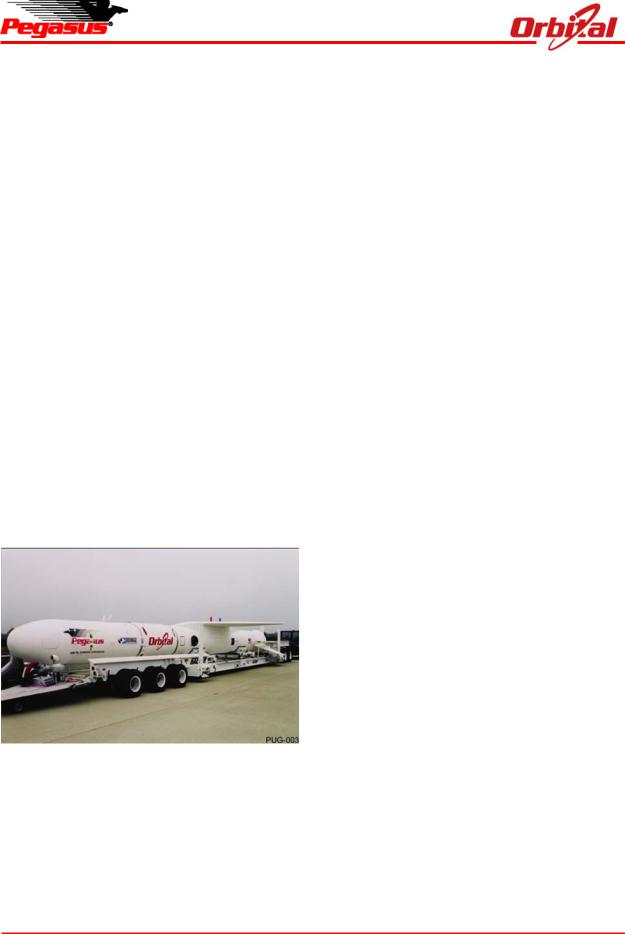
Pegasus User’s Guide
range coordination, launch site processing, and operations. The mission team is responsible for ensuring all mission requirements have been satisfied.
2. PEGASUS DESCRIPTION
The Pegasus User’s Guide is dedicated to the discussion of the Pegasus XL configuration, capabilities, and associated services.
2.1. Pegasus XL Vehicle Description
Pegasus XL is a winged, three-stage, solid rocket booster that weighs approximately 23,130 kg (51,000 lbm), and measures 16.9 m (55.4 ft) in length and 1.27 m (50 in.) in diameter, and has a wing span of 6.7 m (22 ft). Figure 2-1 shows the Pegasus on the Assembly Integration Trailer (AIT). Pegasus is lifted by the OCA to a level flight condition of about 11,900 m (39,000 ft) and Mach 0.82. Five seconds after release from the OCA Stage 1 motor ignition occurs. The vehicle’s autonomous guidance and flight control system provide the guidance necessary to insert payloads into a wide range of orbits.
Figure 2-1. Pegasus XL on the Assembly and Integration Trailer (AIT)
Figure 2-2 shows an expanded view of the Pegasus XL configuration. The Pegasus Vehicle design combines flight-proven technologies, and conservative design margins to achieve performance and reliability. The vehicle incorporates eight major elements:
Three solid rocket motors;
A payload fairing;
An avionics assembly;
A lifting wing;
Aft skirt assembly including three movable control fins; and
A payload interface system.
Pegasus also has an option for a liquid propellant fourth stage, HAPS (see Section 10). Figure 2-3 illustrates Pegasus XL’s principle dimensions.
2.1.1. Solid Rocket Motors
The three solid rocket motors were designed and optimized specifically for Pegasus and include features that emphasize reliability and manufacturability. The design was developed using previously flight-proven and qualified materials and components. Common design features, materials, and production techniques are applied to all three motors to maximize cost efficiency and reliability. These motors are fully flight-qualified. Typical motor characteristics are shown in Figure 2-4.
2.1.2. Payload Fairing
The Pegasus payload fairing consists of two composite shell halves, a nose cap integral to a shell half, and a separation system. Each shell half is composed of a cylinder and ogive sections. The two halves are held together with a base frangible joint, two titanium straps along the cylinder and a retention bolt in the nose. A cork and Room Temperature Vulcanizing (RTV) Thermal Protection System (TPS) provides protection to the graphite composite fairing structure. The amount of TPS applied has been determined to optimize fairing performance and payload environmental protection.
The two straps are tensioned using bolts, which are severed during fairing separation with pyrotechnic bolt cutters, while the retention bolt in the nose is released with a pyrotechnic separation nut. The base of the fairing is separated with
Release 7.0 |
Apr 2010 |
3 |

Pegasus User’s Guide
Figure 2-2. Expanded View of Pegasus XL Configuration
Orbital’s low-contamination frangible separation joint. These ordnance events are sequenced for proper separation dynamics. A hot gas generator internal to the fairing is also activated at separation to pressurize two piston-driven pushoff thrusters. These units, in conjunction with cams, force the two fairing halves apart. The halves rotate about fall-away hinges, which guide them away from the satellite and launch vehicle.
The fairing and separation system were fully qualified through a series of structural, functional, and contamination ground vacuum tests and have been successfully flown on all Pegasus XL missions. Section 5 presents a more detailed description of the fairing separation sequence and the satellite dynamic envelope.
2.1.3. Avionics
The Pegasus avionics system is a digital distributed processor design that implements developments in hardware, software, communi-
cations, and systems design. Mission reliability is achieved by the use of simple designs, high reliability components, high design margins, and extensive testing at the component, subsystem, and system level.
The heart of the Pegasus avionics system is a multiprocessor, 32-bit flight computer. The flight computer communicates with the Inertial Measurement Unit (IMU), the launch panel electronics on the carrier aircraft, and all vehicle subsystems using standard RS-422 digital serial data links. Most avionics on the vehicle feature integral microprocessors to perform local processing and to handle communications with the flight computer. This RS-422 architecture is central to Pegasus rapid integration and test, as it allows unit and system-level testing to be accomplished using commercially available ground support equipment with off-the-shelf hardware.
Release 7.0 |
Apr 2010 |
4 |
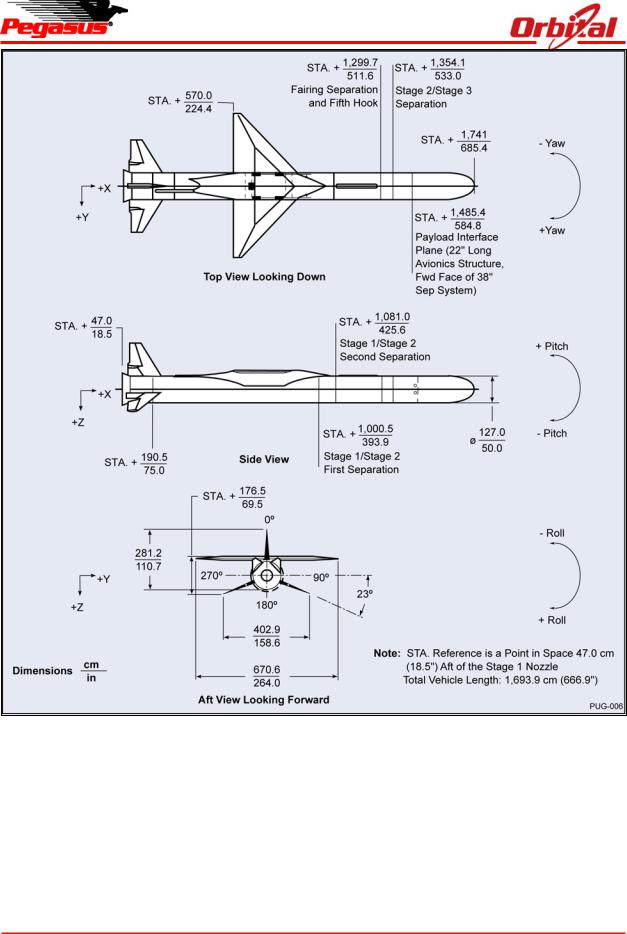
Pegasus User’s Guide
Figure 2-3. Principle Dimensions of Pegasus XL (Reference Only)
2.1.4. Flight Termination System
The Pegasus Flight Termination System (FTS) supports ground-initiated command destruct as well as the capability to sense inadvertent stage separation and automatically destruct the rocket. The FTS is redundant, with two independent safe and arm devices, receivers, logic units, and batteries.
2.1.5. Attitude Control Systems
After release from the OCA, the Pegasus attitude control system is fully autonomous. A combination of open-loop steering and closed-loop guidance is employed during the flight. Stage 1 guidance utilizes a pitch profile optimized by ground simulations. Stage 2 and Stage 3 guidance uses an adaptation of an algorithm that was first
Release 7.0 |
Apr 2010 |
5 |

Pegasus User’s Guide
Figure 2-4. Typical Pegasus XL Motor Characteristics in Metric (English) Units
developed for the Space Shuttle ascent guidance. Attitude control is closed-loop.
The vehicle attitude is controlled by the Fin Actuator System (FAS) during Stage 1 flight. This consists of electrically actuated fins located at the aft end of Stage 1. For Stage 2 and Stage 3 flight, a combination of electrically activated Thrust Vector Controllers (TVCs) on the Stage 2 and Stage 3 solid motor nozzles and a GN2 Reaction Control System (RCS) located on the avionics section, control the vehicle attitude.
Figure 2-5 summarizes the attitude and guidance modes during a typical flight, although the exact sequence is controlled by the Mission Data Load (MDL) software and depends on mission-specific requirements.
2.1.6. Telemetry Subsystem
The Pegasus XL telemetry system provides realtime health and status data of the vehicle avionics system, as well as key information regarding the position, performance, and environment of the Pegasus XL vehicle. This data is used by Orbital and the range safety personnel to evaluate system performance.
Pegasus contains two separate telemetry systems. The first provides digital data through telemetry multiplexers (MUXs), which gather data from each sensor, digitize it, then relay the information to the flight computer. This Pegasus telemetry stream provides data during ground processing, checkout, captive carry, and during launch. During captive carry, Pegasus telemetry is downlinked to the ground and recorded onboard the OCA. Some payload telemetry data can be interleaved with Pegasus data as a nonstandard service. The second system provides analog environments data, which are transmitted via a wideband data link and recorded for post-flight evaluation.
2.1.7. Major Structural Subsystems 2.1.7.1. Wing
The Pegasus wing uses a truncated delta platform with a double wedge profile. Wing panels are made of a graphite-faced foam sandwich. Channel section graphite spars carry the primary bending loads and half-ribs, and reinforcing layups further stabilize the panels and reduce stress concentrations. The wing central box structure has fittings at each corner that provide the structural interface between the Pegasus and the OCA.
Release 7.0 |
Apr 2010 |
6 |
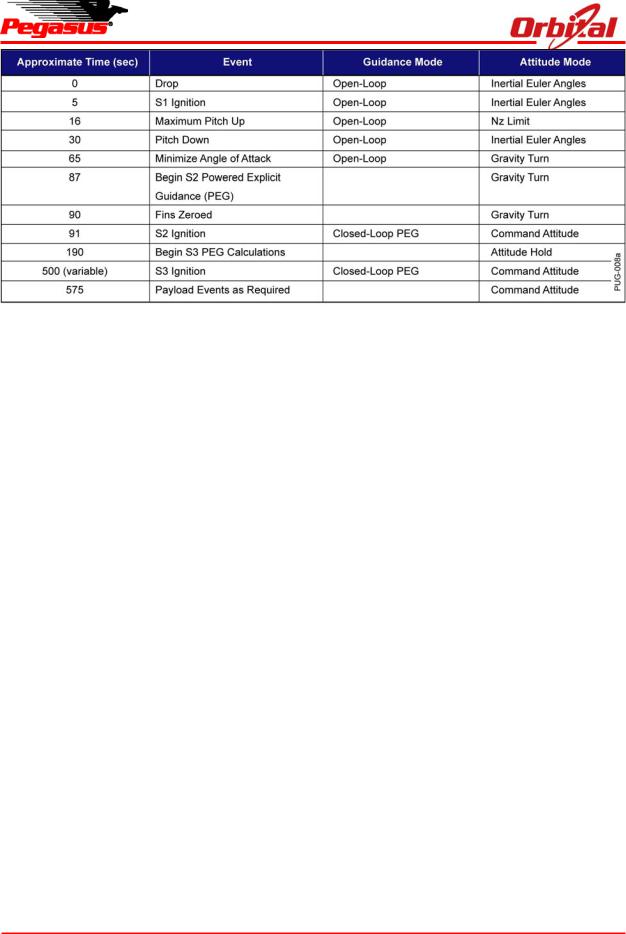
Pegasus User’s Guide
Figure 2-5. Typical Attitude and Guidance Modes Sequence
2.1.7.2. Aft Skirt Assembly
The aft skirt assembly is composed of the aft skirt, three fins, and the fin actuator subsystem. The aft skirt is an all-aluminum structure of conventional ring and stressed-skin design with machined bridge fittings for installation of the electromechanical fin actuators. The skirt is segmented to allow installation around the first stage nozzle. Fin construction is a one-piece solid foam core and wet-laid graphite composite construction around a central titanium shaft.
2.1.7.3. Payload Interface Systems
Multiple mechanical and electrical interface systems currently exist to accommodate a variety of spacecraft designs. Section 5.0 describes these interface systems. To ensure optimization of spacecraft requirements, payload specific mechanical and electrical interface systems can be provided to the payload customer. Payload mechanical fit checks and electrical interface testing with these spacecraft unique interface systems are encouraged to ensure all spacecraft requirements are satisfied early in the processing flow.
2.2. Orbital Carrier Aircraft
Orbital furnishes and operates the OCA. After integration at Orbital’s West Coast integration site at VAFB, the OCA can provide polar and high-
inclination launches utilizing the tracking, telemetry, and command (TT&C) facilities of the WR. The OCA can provide lower inclination missions from the East Coast using either the NASA or ER TT&C facilities or from the Reagan Test Site from the Kwajalein Atoll, as well as equatorial missions from the Kwajalein Atoll. The OCA is made available for mission support on a priority basis during the contract-specified launch window.
The unique OCA-Pegasus launch system accommodates two distinctly different launch processing and operations approaches for nonVAFB launches. One approach (used by the majority of payload customers) is to integrate the Pegasus and payload at the VAB and then ferry the integrated Pegasus and payload to another location for launch. This approach is referred to as a “ferry mission.” The second approach is referred to as a “campaign mission.” A campaign mission starts with the build up of the Pegasus at the VAB. The Pegasus is then mated to the OCA at VAFB and ferried to the integration site where the Pegasus and payload are fully integrated and tested. At this point, the launch may either occur at the integration site, or the integrated Pegasus and payload may be ferried to another location for launch.
Release 7.0 |
Apr 2010 |
7 |

Pegasus User’s Guide
The OCA also has the capability to ferry Pegasus across the United States or across the ocean (depending on landing site) to support ferry and campaign missions.
3. GENERAL PERFORMANCE CAPABILITY
This section describes the orbital performance capabilities of the Pegasus XL vehicle with and without the optional HAPS described in Section 10. Together these configurations can deliver payloads to a wide variety of circular and elliptical orbits and trajectories, and attain a complete range of prograde and retrograde inclinations through a suitable choice of launch points and azimuths. In general, the optional HAPS will provide additional performance at higher altitudes, as well as providing a more accurate insertion orbit capability.
From the WR, Pegasus can achieve inclinations between 70° and 130°. A broader range of inclinations may be achievable, subject to additional analyses and coordination with Range authorities. Additionally, lower inclinations can be achieved through dog-leg trajectories, with a commensurate reduction in performance. Some specific inclinations within this range may be limited by stage impact point or other restrictions. Other inclinations can be supported through use of Wallops Flight Facility (WFF), Eastern Range (ER), Reagan Test Site (RTS) Kwajalein, or other remote TT&C sites. Pegasus requirements for remote sites are listed in Appendix D.
3.1. Mission Profiles
This section describes circular low earth orbit mission profiles. Performance quotes for noncircular orbits will be provided on a missionspecific basis.
Profiles of typical missions performed by Pegasus XL with and without HAPS are illustrated in Figure 3-1 and Figure 3-2. The depicted profile begins after the OCA has reached the launch
point, and continues through orbit insertion. The time, altitude, and velocity for the major ignition, separation, and burnout events are shown for a typical trajectory that achieves a 741 km (400 nm) circular, polar (90° inclination) orbit after launch from the WR. These events will vary based on mission requirements.
The typical launch sequence begins with release of Pegasus from the carrier aircraft at an altitude of approximately 11,900 m (39,000 ft) and a speed of Mach 0.82. Approximately 5 seconds after drop, when Pegasus has cleared the aircraft, Stage 1 ignition occurs. The vehicle quickly accelerates to supersonic speed while beginning a pull up maneuver. Maximum dynamic pressure is experienced approximately 30 seconds after ignition. At approximately 15-20 seconds, a maneuver is initiated to depress the trajectory and the vehicle transitions to progressively lower angles of attack.
Stage 2 ignition occurs shortly after Stage 1 burnout, and the payload fairing is jettisoned during Stage 2 burn as quickly as fairing dynamic pressure and payload aerodynamic heating limitations will allow, approximately 112,000 m (366,000 ft) and 121 seconds after drop. Stage 2 burnout is followed by a long coast, during which the payload and Stage 3 achieve orbital altitude. For a non-HAPS Pegasus configuration, Stage 3 then provides the additional velocity necessary to circularize the orbit. Stage 3 burnout typically occurs approximately 10 minutes after launch and 2,200 km (1,200 nm) downrange of the launch point.
An FAS, in conjunction with three aerodynamic fins, provides attitude control from drop through Stage 1 separation. Pitch and yaw attitude control during Stage 2 and Stage 3 powered flight is provided by the motor TVC system while roll attitude is controlled by the nitrogen cold gas RCS. The RCS also provides three-axis control during coast phases of the trajectory.
Release 7.0 |
Apr 2010 |
8 |
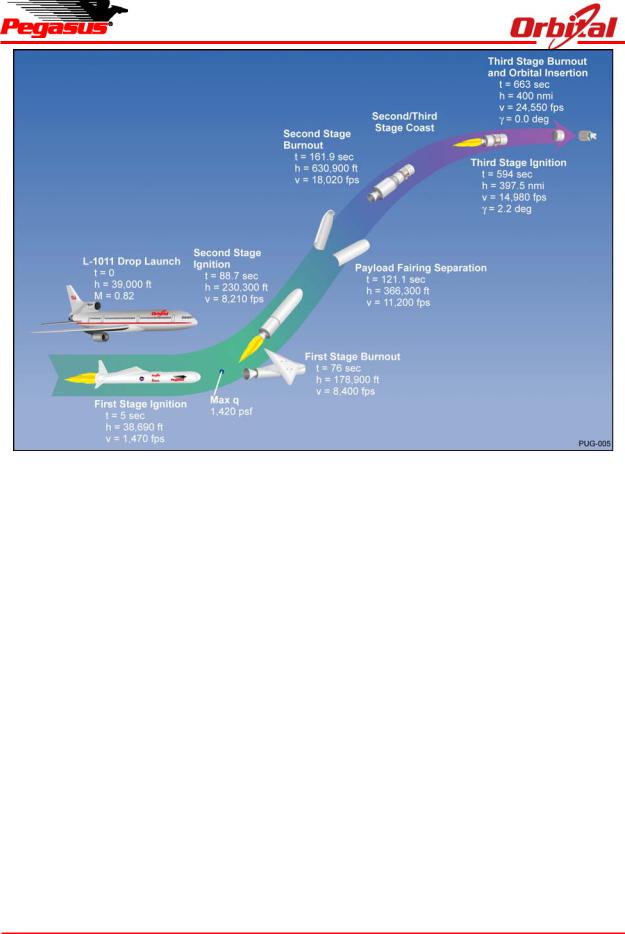
Pegasus User’s Guide
Figure 3-1. Pegasus XL Mission Profile to 741 km (400nmi) Circular, Polar Orbit with a 227 kg (501 lbm) Payload
3.2. Performance Capability
Performance capabilities to various orbits for the Pegasus XL are illustrated in Figure 3-3 and Figure 3-4 (HAPS configuration). These performance data were generated using the Program to Optimize Simulated Trajectories (POST), which is described below. Precise performance capabilities to specific orbits are typically provided per the documentation schedule shown in Section 8.0.
3.3. Trajectory Design Optimization
Orbital designs a unique mission trajectory for each Pegasus flight to maximize payload performance while complying with any applicable payload and launch vehicle constraints. In this process, a 3DOF simulation is developed using the current Pegasus mass properties, aerodynamic models, and motor ballistics data, and the desired target orbit and any applicable trajectory constraints are specified. POST then
uses a set of specified control parameters to iterate on the trajectory design until an optimal solution is identified which maximizes performance to the desired target orbit subject to the specified constraints. Typically, these constraints may include limitations on the angle of attack profile, dynamic loading constraints, payload environmental constraints such as heat rate, and Range-imposed constraints on the launch azimuth and spent stage impact locations. After POST has been used to determine the optimal trajectory design, a high-fidelity, Pegasus-specific, 6DOF simulation is then developed to conduct detailed trajectory analyses to verify the acceptability of the trajectory design and to verify robust control system stability margins.
3.4. Orbit Insertion Accuracy
The estimated orbit insertion errors for Pegasus vary from mission to mission and are influenced by a variety of factors including the target orbit,
Release 7.0 |
Apr 2010 |
9 |
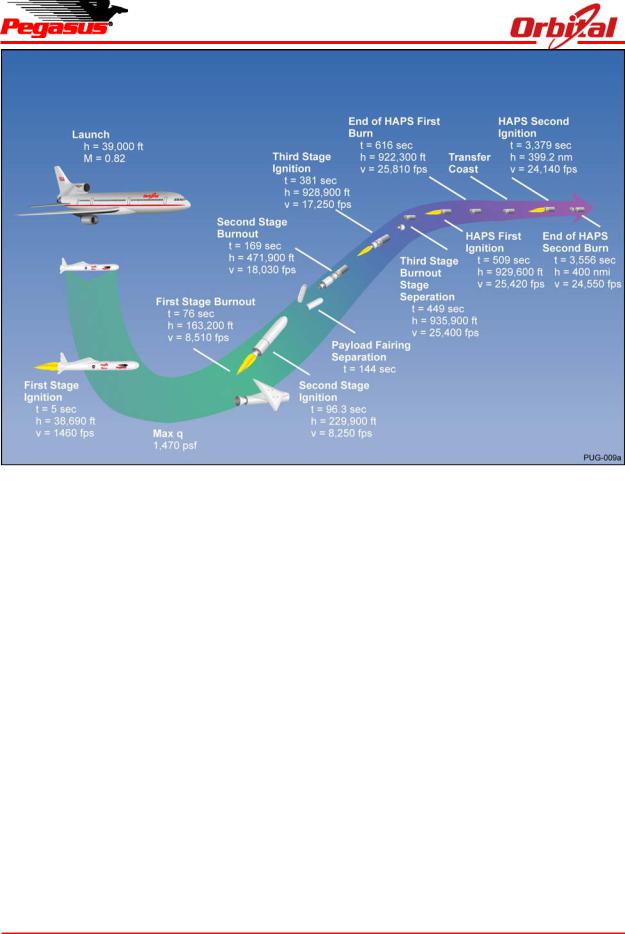
Pegasus User’s Guide
Figure 3-2. Pegasus XL with HAPS Mission Profile to 741 km (400nmi) Circular, Polar Orbit with a 227 kg (501 lbm) Payload
trajectory design, payload mass, and the guidance strategy requested by the payload. As a result, the specific Pegasus orbit accuracy capabilities for a particular mission are generally determined only after these mission-specific details are defined and detailed mission-specific analyses have been performed. However, Figure 3-5 provides estimates of 3-sigma orbit insertion errors for both Pegasus XL and Pegasus XL with HAPS vehicle configurations, which are representative of typical Pegasus missions. For non-HAPS configurations, these errors are generally dominated by the impulse variability associated with Stage 3. This variability is also responsible for the generally larger magnitude errors for the non-insertion apse relative to the insertion apse.
3.4.1. Actual Pegasus Insertion Accuracies
Figure 3-6 shows the actual Pegasus orbital insertion accuracies achieved for all missions since Flight 10. As this figure demonstrates, a
large majority of these missions resulted in perigee and apogee altitudes within 30 km of the desired target values and inclination errors of less than 0.05 degrees.
3.4.2. Error-Minimizing Guidance Strategies
Due to the large amount of actual flight experience Pegasus has accumulated to date, the Pegasus Program has been able to continually refine and improve the fidelity and accuracy of the Pegasus vehicle simulation. This process has allowed us to develop a high degree of confidence in the Pegasus simulation analysis results and to accurately predict mission performance in flight.
To ensure that even a 3-sigma low-performing Pegasus vehicle will achieve the required orbit, Pegasus trajectories include a 67 m/sec (220 ft/sec) guidance reserve. Pegasus flight software provides the capability to manage this reserve through the use of a variety of different
Release 7.0 |
Apr 2010 |
10 |
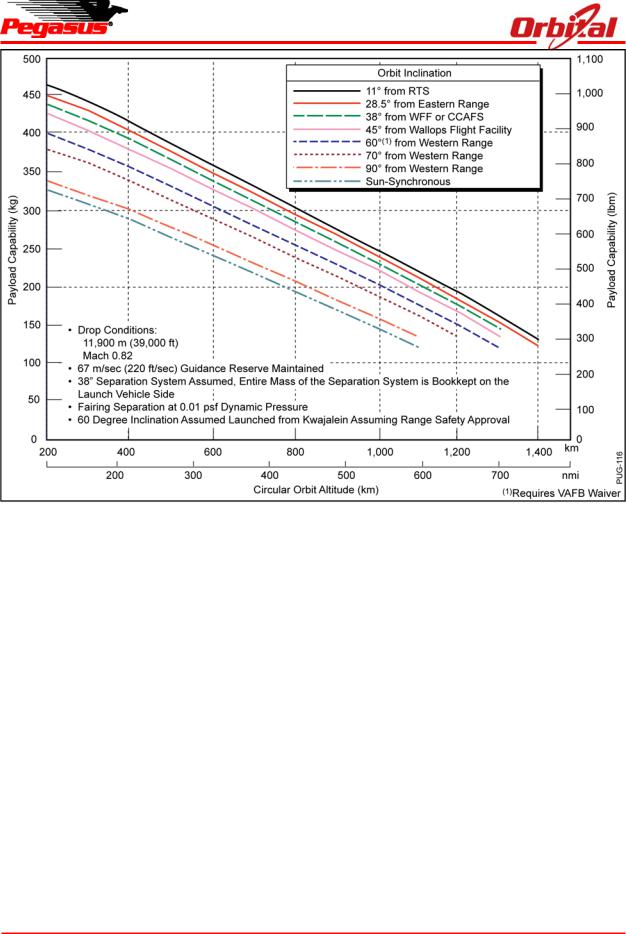
Pegasus User’s Guide
Figure 3-3. Pegasus XL Without HAPS Performance Capability
guidance strategies that are designed and tailored to meet specific mission objectives. These strategies fall into several basic categories:
(1)Minimize Insertion Errors. Using this strategy, the guidance system manages the excess vehicle energy by implementing out-of-plane turning during Stage 2 and Stage 3 burns as required, and by adjusting the timing of Stage 3 ignition. This “energy-scrubbing” strategy results in the smallest possible insertion errors for both apogee and perigee altitudes.
(2)Maximize Insertion Altitude. Using this strategy, excess vehicle performance is conserved to maximize the altitude at insertion. This allows the customer to achieve the highest possible circular orbit altitude
based on the actual vehicle performance while minimizing the eccentricity of the final orbit.
(3)Maximize Insertion Velocity. Using this strategy, excess vehicle performance is conserved to maximize velocity at insertion. This allows the customer to use the excess guidance reserve to increase the expected apogee (non-insertion apse) altitude while continuing to maintain a precise perigee (insertion apse) altitude.
(4)Some Combination of (2) and (3). Options 2 and 3 represent the two endpoints of a spectrum of potential guidance strategies that can be combined and tailored to achieve mission-specific guidance objectives. Both insertion altitude and velocity may be maximized to achieve the highest possible
Release 7.0 |
Apr 2010 |
11 |

Pegasus User’s Guide
Figure 3-4. Pegasus XL With HAPS Performance Capability
orbit energy, or specific altitude and velocity thresholds may be defined, which trigger energy-scrubbing only in the event that the thresholds are exceeded. The optimal strategy for a particular mission will therefore depend on the specific guidance objectives.
Figure 3-5. 3-sigma Injection Accuracies
Typical of Pegasus XL Missions
3.5. Collision/Contamination Avoidance Maneuver
Following orbit insertion, the Pegasus Stage 3 RCS or HAPS will perform a Collision/Contam-
ination Avoidance Maneuver (C/CAM). The C/CAM consists of a series of maneuvers designed to both minimize payload contamination and the potential for recontact between Pegasus hardware and the separated payload.
Orbital will perform a recontact analysis for post separation events. Orbital and the payload contractor are jointly responsible for determination of whether a C/CAM is required.
A typical C/CAM (for a non-HAPS configuration) consists of the following steps:
(1)At payload separation +3 seconds, the launch vehicle performs a 90° yaw maneuver designed to direct any remaining Stage 3 motor impulse in a direction that will increase
Release 7.0 |
Apr 2010 |
12 |
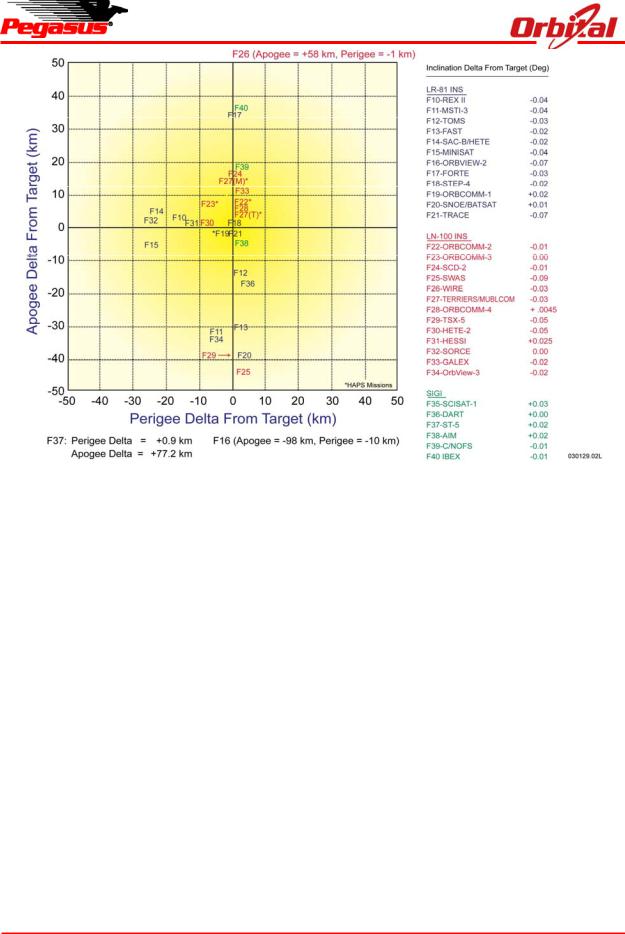
Pegasus User’s Guide
Figure 3-6. Typical and Recent Pegasus Orbital Accuracy
the separation distance between the two bodies.
(2)At payload separation +300 seconds, the launch vehicle begins a “crab-walk” maneuver. This maneuver, performed through a series of RCS thruster firings, is designed to impart a small amount of delta velocity in a direction designed to increase the separation distance
between Pegasus and the payload. The maneuver is terminated approximately 600 seconds after separation.
At the completion of the C/CAM, all remaining nitrogen and/or hydrazine is depleted.
4. PAYLOAD ENVIRONMENTS
The following subsections present the maximum payload environment levels during Pegasus captive carry and powered flight. The acoustic,
vibration, shock, and acceleration environments presented below apply to the launch vehicle with a single payload using either the 38" or 23" payload adapter. The payload environments associated with the use of alternative separation systems, a nonseparating payload interface, or multiple payload attach fittings will differ from those presented below.
The electromagnetic radiation and thermal environments presented below apply to all launch vehicle and payload configurations.
4.1. Design Loads
The primary support structure for the spacecraft shall possess sufficient strength, rigidity, and other characteristics required to survive the critical loading conditions that exist within the envelope of handling and mission requirements, including worst-case predicted ground, flight, and orbital
Release 7.0 |
Apr 2010 |
13 |

Pegasus User’s Guide
loads. It shall survive those conditions in a manner that ensures safety and that does not reduce the mission success probability. The primary support structure of the spacecraft shall be electrically conductive to establish a single point electrical ground. Spacecraft design loads are defined as follows:
Design Limit Load — The maximum predicted ground-based, captive carry, or powered flight load, including all uncertainties.
Design Yield Load — The Design Limit Load multiplied by the required Yield Factor of Safety (YFS) indicated in Figure 4-1. The payload structure must have sufficient strength to withstand simultaneously the yield loads, applied temperature, and other accompanying environmental phenomena for each design condition without experiencing detrimental yielding or permanent deformation.
Design Ultimate Load — The Design Limit Load multiplied by the required Ultimate Factor of Safety (UFS) indicated in Figure 4-1. The payload structure must have sufficient strength to withstand simultaneously the ultimate loads, applied temperature, and other accompanying environmental phenomena without experiencing any fracture or other failure mode of the structure.
4.2. Payload Testing and Analysis
Sufficient payload testing and/or analysis must be performed to ensure the safety of ground and aircraft crews and to ensure mission success. The payload design must comply with the testing and design factors of safety in Figure 4-1 and the FAA regulations for the carrier aircraft listed in the CFR14 document, FAR Part 25. UFS shown in Figure 4-1 must be maintained per Orbital SSD TD-0005. At a minimum, the following tests must be performed:
Structural Integrity — Static loads or other tests shall be performed that combine to encompass the acceleration load environment presented in Section 4.3. Test level requirements are defined in Figure 4-1.
Random Vibration — Test level requirements are defined in Figure 4-2.
4.3. Payload Acceleration Environment
Maximum expected loads during captive carry and launch are shown in Figures 4-3, 4-4, and 4-5.
The Pegasus air-launch operation results in a launch vehicle/OCA separation transient at drop. The drop transient acceleration limits presented here are based on two assumptions:
(1)Pegasus Standard 23” or 38” payload separation system is used.
(2)The first fundamental lateral frequency of the spacecraft cantilevered at the payload interface (excluding the payload separation system) is greater than 20 Hz.
If either assumption is violated, mission-specific analyses are required. For all missions, accurate estimation of the drop transient loading requires a coupled loads analysis (CLA), which uses Orbital and customer-provided finite element models to predict the transient environment (see Section 8.3.3 for details).
Transient loading also exists due to motor ignition. Stage 1 provides the worst-case loading due to motor ignition. The Stage 1 ignition acceleration limits at the payload interface are listed in Figure 4-3. The Stage 1 shock response spectrum (SRS) at the payload interface is shown in Figure 4-6. As is the case with the drop transient, accurate estimation of loading requires a CLA. The Stage 1 ignition transient CLA requires finite element models of the Pegasus avionics structure, payload separation system, and the payload.
4.4. Payload Random Vibration Environment
The maximum expected random vibration levels at the payload interface are shown in Figure 4-7. Random vibration data recorded during multiple Pegasus missions was used to create this overall
Release 7.0 |
Apr 2010 |
14 |
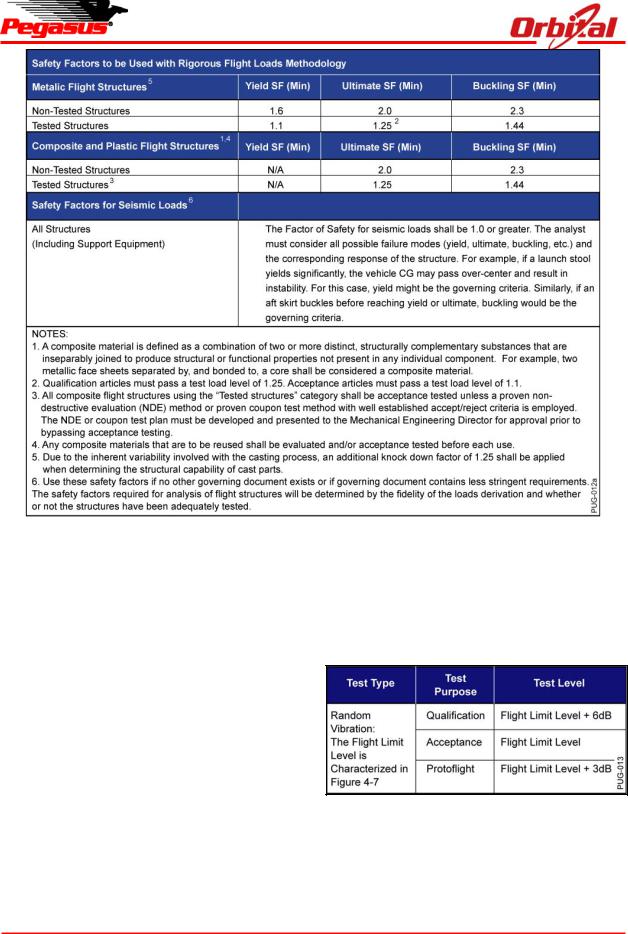
Pegasus User’s Guide
Figure 4-1. Factors of Safety for Payload Design and Test
envelope that encompasses all phases of a Pegasus launch operation including OCA takeoff, captive carry, and powered flight.
A +3 dB factor should be added to this spectrum for 75 seconds in each axis for payload standard vibration testing to account for fatigue duration effects to encompass at least two launch attempts and powered flight.
4.5. Sinusoidal Vibration
The Pegasus launch vehicle has no significant sustained sinusoidal vibration environments during captive carry or powered flight.
4.6. Payload Shock Environment
The maximum expected shock response spectrum at the base of the payload from all launch vehicle
events is shown in Figure 4-8. The flight limit levels are derived from ground stage and payload separation test data assuming a 38” Orbitalsupplied separation system.
Figure 4-2. Payload Testing Requirements
4.7. Payload Acoustic Environment
The maximum expected acoustic levels within the payload fairing are shown in Figure 4-9. Acoustic data recorded during previous Pegasus missions
Release 7.0 |
Apr 2010 |
15 |
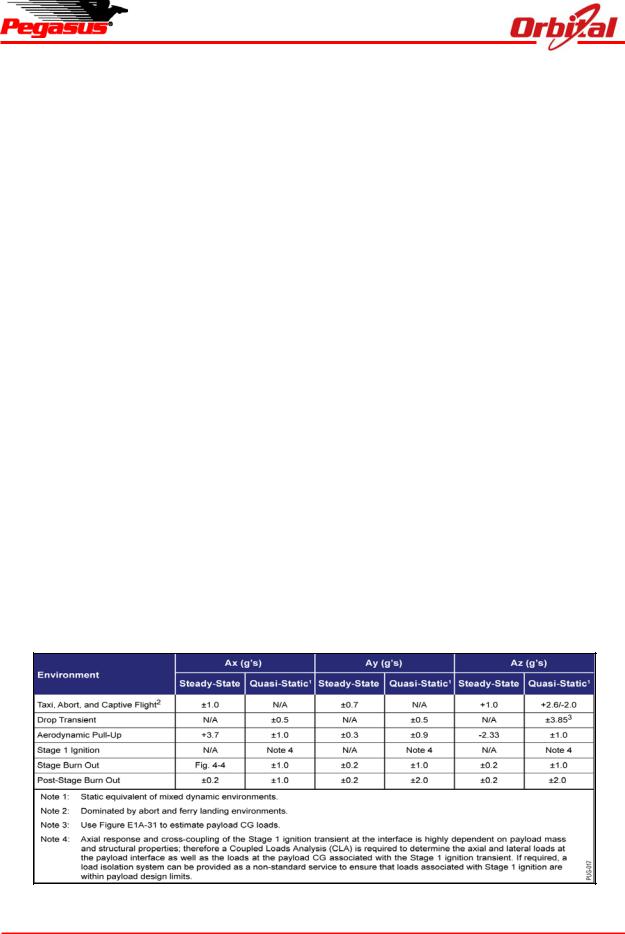
Pegasus User’s Guide
was used to create this overall envelope that encompasses all phases of Pegasus launch operation including OCA takeoff, captive carry, and powered flight.
A +6 dB factor should be added to this spectrum for 75 seconds for payload standard acoustic testing to account for fatigue duration effects to encompass at least two launch attempts and powered flight.
4.8. Pressure Profile
Due to the low pressure decay rate associated with OCA ascent and low initial static pressure at drop, the depressurization rates for the Pegasus payload fairing are less than 0.3 psi/sec. The internal pressure at fairing jettison is well below 0.1 psia. Representative pressure profiles for captive carry and powered flight are provided in Figures 4-10 and 4-11.
4.9. Payload Thermal Environment
The payload thermal environment is maintained during all phases of integrated operations including payload processing, fairing encapsulation, transportation of the launch vehicle, ground operations at the flight line and launch operations.
4.9.1. Payload Processing
During payload processing, the temperature and humidity of the spacecraft processing areas within Building 1555 are maintained within a range of 18 to 29 ºC (64.4 to 84.2 ºF) and ≤55%, respectively. Following encapsulation of the payload, but prior to transportation of the Pegasus vehicle to the Hot Pad, the fairing is continuously purged with filtered air. The temperature and humidity limits are the same as listed above. The flowrate of air through the fairing is maintained between 50 and 200 cfm. The air flow enters the fairing forward of the payload and exits aft of the payload. There are baffles on the inlet that minimize the impingement velocity of the air on the payload.
4.9.2. Transportation
During transportation of the Pegasus vehicle to the Hot Pad, the fairing is continuously purged with filtered and dried ambient air. The air temperature is not actively controlled; however, transportation operations are performed only when the ambient temperature ensures that the air supplied to the fairing will be between 2 to 29 ºC (35.6 to 84.2 ºF). The relative humidity of the air supplied to the
Figure 4-3. Pegasus Design Limit Load Factors
Release 7.0 |
Apr 2010 |
16 |

Pegasus User’s Guide
Figure 4-4. Pegasus XL Maximum Quasi Steady Acceleration as a Function of Payload Weight
Figure 4-5. Pegasus Net CG Load Factor Predictions
Release 7.0 |
Apr 2010 |
17 |
